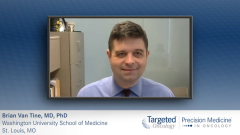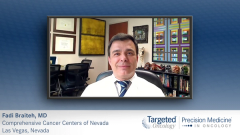
Approach to GIST Sequencing
Experts in the field of gastrointestinal stromal tumors (GISTs) discuss the role of sequencing therapy in the frontline and later-line settings.
Brian Van Tine, MD, PhD: Hello, and thank you for joining this Targeted Oncology presentation on precision medicine entitled, “Advances in Later Lines of Therapy for GIST.” Gastrointestinal stromal tumors [GISTs], although rare, have recently seen multiple advances in treatment. Specific GIST subtypes, including patients with KIT and platelet-derived growth factor receptor alpha [PDGFRA] mutations, have recently benefited from FDA-approved targeted therapies. Today we’re going to discuss these advances and dive into the evolving landscape and ongoing unmet needs.
I am Brian Van Tine, MD, PhD. I’m an associate professor in the division of medical oncology at Washington University [School of Medicine] in St. Louis. Not only am I the Sarcoma Program director, but I’m co-director of our Phase 1 program. I’m very excited to be joined today by Fadi Braiteh, MD, a medical oncologist and director of the Translational Oncology Program and the GI Malignancies Program at the Comprehensive Cancer Centers of Nevada, in Las Vegas. Thank you so much for joining us. Let’s begin.
As I represent academia and you’re in private practice, I think the first question we should address is the approach to sequencing therapy in patients with gastrointestinal stromal tumors. This patient population is separated into 2 large groups. Most patients are cared for within the private practice realm. The reason for our conversation today is that it’s become more complex with the addition of 2 drugs. And so, Fadi, what is your approach to frontline and later-line sequencing of GIST?
Fadi Braiteh, MD: Thank you for having me. It’s very important to recognize that from a historical point of view, gastrointestinal stromal tumors, are really a landmark in the development of precision oncology. I remember vividly, 20 years ago, when the BCR-ABL inhibitor imatinib was developed for CML [chronic myeloid leukemia]. And I remember it being ground changing when they reported the drug being a c-KIT inhibitor and attempting to use the drug in the first patient with GIST. Some people may remember this phenomenal response on a PET [positron emission tomography]/CT scan. This was really the beginning of an era of precision oncology in solid tumors.
Now, I say precision oncology, although at the time we were recognizing, by immunohistochemistry, c-KIT and CD117 in GIST. It even shifted the incidence of disease. Pathologists started recognizing it under the pressure of medical oncologists and surgeons. And of course, we went on a journey of treating with imatinib at the standard dose, 400 mg. Then there was research showing that some patients may need an even higher dose. We started looking at the sequencing of the gene or doing specific PCR [polymerase chain reaction] testing looking at exon 9 versus exon 11 in the c-KIT mutations to determine how we would treat patients.
While things evolved, in terms of treating these patients, we started identifying some patients who were not responding well or had progression of disease. In parallel, we established one of the first solid tumors treated with a biologic in the adjuvant setting, with the tyrosine kinase inhibitor. We moved from 1 year to 3 years. It has been a fascinating journey for a very rare disease. In the United States, we see about 5000 or 6000 cases. But what we will do with these patients when the disease progresses?
The lesson we learn in training or even in the community, although we have very few cases, is that the pattern of progression is a bit difficult to recognize compared to other solid tumors. We started looking at the necrotic center and that blossoming or budding of a new tumor as progression of disease. So this is something that is really different. We also started learning that to treat a GIST, we need to establish what the driver mutation is. While we recognize that the majority of patients with GIST have an activating mutation in the c-KIT gene, there is another subset where it is more in the PDGFRA mutation—about 10%—and we recognize 3 different mutations that drive that. And of course, there is another subset, although very rare. About 1% to 2% of patients may harbor BRAF, NF1, succinate dehydrogenase deficiency, etc.
Now, remember this was happening in the late years of 2007, 2008. But there was another wave of precision oncology starting to put pressure on oncologists. We’re talking about EGFR mutations in lung cancer and ALK rearrangements. Then we started having other diseases for which we really needed to know about markers, such as the BRAF mutation in melanoma, and then in colorectal cancer and breast cancer, the KRAS mutation. Luckily today, we have the opportunity to do next-generation sequencing, and many of the commercial laboratories do up to 600 of these genes. The genes of interest that are actionable in oncology in general and in GIST are mostly included. The question is, when to test. Every new case of GIST needs to be tested. The second challenge that we need to reinforce is, upon progression, we need to resample the tumor. It’s not just a random biopsy of the tumor, but a sample of that progressive disease. We try to do another molecular profile and adjust treatment to that purpose. Although the guidelines now are a bit geared toward treatment after progression, after you establish the first line of treatment, it becomes a bit molecularly agnostic—establishing frontline imatinib, second-line sunitinib, third-line regorafenib. And after that, it has been, until last year, a wild card.
Brian Van Tine, MD, PhD: You really have this experience, and I think it is really fun to talk about.
Transcript edited for clarity.















































